It’s never fun discovering that your RV’s refrigerator is on the fritz, especially when you’re out on the road with no access to your dealer or repair service. Luckily, you can often return it back to service yourself with just a few troubleshooting tips.
How to Diagnose RV Refrigerator Problems
First, make sure the unit is level. Then determine if it is working at all, or is completely non-functional. This is best done with a thermometer, although in a pinch you can usually tell by placing your bare hand against the cooling coils inside the main food compartment and freezer. You can also check the back of the refrigerator to see if the flame is present, if it is on the gas setting. If it is on electric setting, hold your hand near the heating element area in the back of the unit (but avoid touching as it may cause a burn).
Use thermometers designed for use in refrigerators. It’s best to use one in each compartment.The cooling effect from most RV refrigerators originates in the freezer compartment and then goes into the main compartment, so if the freezer is okay but not the main compartment, you likely have reduced airflow. The fan in the freezer, called an evaporator fan, moves cooled air from the freezer into the food compartment through a controlled duct called a diffuser. The diffuser is located at the upper rear center of the food compartment. Listen for the evaporator fan running in the freezer. Also check the diffuser duct to see if it is clogged with ice. Evaporator fans cycle on and off so if you don’t hear it, wait a while. Some refrigerators shut the fan off when you open the door so listen through the door.
If there’s no cooling, sniff around the refrigerator. Most RV refrigerators are the absorption type, which uses a mixture of water, liquefied ammonia, hydrogen gas, and sodium chromate (the chemical used to line the internal tubes to protect them from the corrosive ammonia) in the cooling coils to transfer heat. On absorption units, if you can smell the odor of ammonia, the heat transferring coils in the cooling system of the refrigerator have leaked out, and will need professional repair or replacement. At this point, contact an RV dealer to determine which option will be most cost effective. Also check to see if the unit is still in warranty.
Many other problems can be handled by you, so if there’s no ammonia odor, continue troubleshooting following these steps. Try operating the fridge in all operating modes. If the unit works on LP gas but not on electric, or vice versa, it means the basic cooling unit is intact.
Use a multimeter to check for voltage to the refrigerator.For full operational capability, an RV absorption-type refrigerator typically needs 120 Volts AC, 12 Volts DC, and a source of LP gas. The gas is usually the default source of heat for the cooling coils, while the 120 Volts is the alternate source, typically used when connected to “shore” power in a campground. The 12 Volts DC is used for the control circuitry, and in some cases to heat the coils.
If the unit operates on LP gas, but not on 120 Volts AC, verify that 120 V AC is available at the back of refrigerator. First, check circuit breakers and fuses at the panel, then check the outlet at the back of the refrigerator for voltage. A multimeter is recommended, but plugging a blow dryer or other device into the outlet can tell you if voltage is present.
Checking for 120 Volts AC at the outlet that powers the refrigerator.Also verify that 12 Volts DC is present at the back of refrigerator. This can be done with a 12 Volt test light or a multimeter. If both voltages are present and all indicator lamps work, check for trouble codes on refrigerators which have this feature. This can lead you to the problem area quickly. The codes and procedure to read them should be in the owner’s booklet, but if that is not available you can find the information on the refrigerator manufacturer’s website.
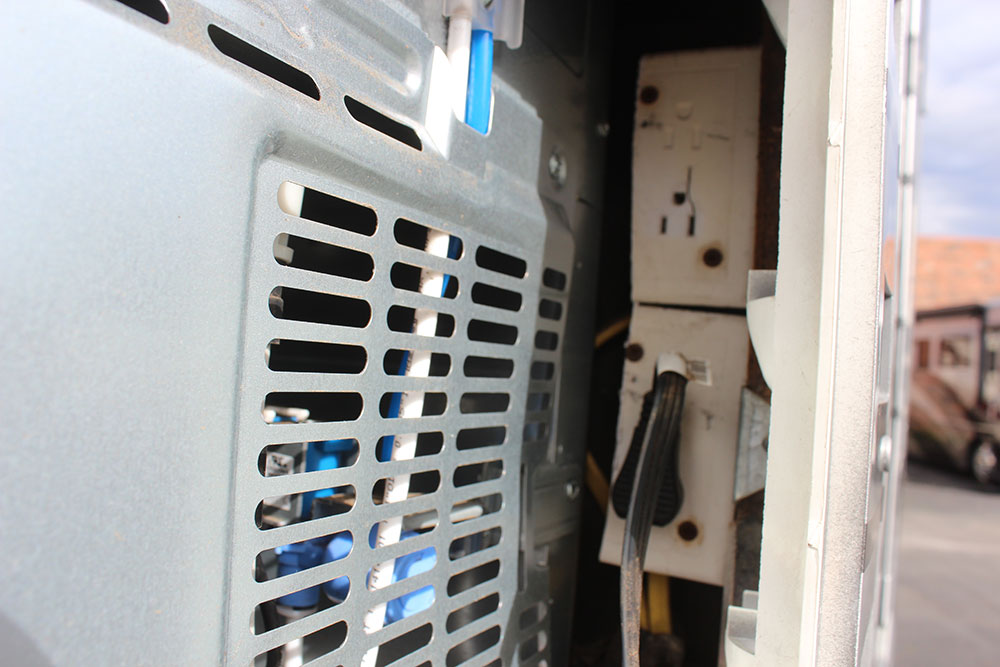 Most refrigerators plug in like this one, for 120 Volt power supply. Check circuit breakers if there is no power.
Most refrigerators plug in like this one, for 120 Volt power supply. Check circuit breakers if there is no power.
To check the 120 Volt AC electric heating element, a multimeter should be used. Be careful because the voltage is hazardous. Do this in dry conditions, wear rubber soled shoes and rubber gloves. If you are unsure of your electrical skills, have this done by a professional.
The wires powering the heating element typically come from the metal enclosure below the cooling unit, accessed from the back of the fridge. Generally only minor removal of shielding is needed for access. This should be done while the unit is unplugged. Test voltage while the heating element is connected and powered up. If voltage is detected at one wire but not the other, the element may be burned out. If there is no voltage at the element, the problem may be in the wiring from the refrigerator circuit board, or the board itself. Testing this may require a qualified RV shop.
If there’s no 12 Volt DC power going to your refrigerator, make sure the batteries are charged and then check fuses and switches.Three-way refrigerators can operate on 12 Volts DC because they have an extra electric heating element. Test voltage at the heating element the same way as the 120 Volt AC units, but use a low voltage (usually 20) DC mode on the multimeter.
If the unit operates on 120 Volts AC but not on LP gas, try to determine if there is a good flame. First check that the LP gas tank has sufficient gas in it, that the valve is on, and any safety devices such as LP alarms have not disconnected the supply. Then switch the controls on for gas burner use. If it lights, but goes out quickly, the thermocouple (which detects the heat from the flame and controls the gas valve) may be faulty. These go bad quite often, and it’s a good idea to carry one with you on trips. The thermocouple is attached to the main gas valve in back of the refrigerator. It has a tube extending toward the gas burner. Usually they can be replaced by owners with some DIY skills.
If the flame doesn’t light, vacuum the burner area to the burner port (or jet). Sometimes rust and other debris drops from the vent and blocks the burner unit. To fix this, remove the metal shielding and use a shop vacuum to clean the area near the burner thoroughly. If necessary, push a thin wire into the burner orifice to unclog it. If the flame remains lit, look for flame quality; it requires a well-shaped flame that’s mostly blue.
If the icemaker is not working, make sure the water valve (located by the exterior access panel) is open.Sometimes, the cooling unit still is charged with the required ammonia mixture, but still doesn’t work. If it appears that the cooling unit needs to be replaced, consider using an old-timer’s trick, and remove the entire refrigerator and place it upside down for a week or so. This sometimes unclogs them and gets them working again, and all it takes is a little labor and time. What do you have to lose?
Rebuilt circuit boards and cooling units are available for many popular RV refrigerators. If they come with a warranty from a reputable supplier, they can get you back on the road with a considerable savings.Many times it’s something minor that causes your refrigerator to malfunction. By checking these items above, it may be possible to avoid a costly refrigerator repair bill. In other cases you can at least give the technician a description of what the problem is and be able to make an informed decision about repairs.
Related video: Tips and Tricks to RV Refrigerator Troubleshooting
Have something to add? Leave a comment below or share with us on Facebook.
Share tips, start a discussion or ask one of our experts or other students a question.
Already a member? Sign in
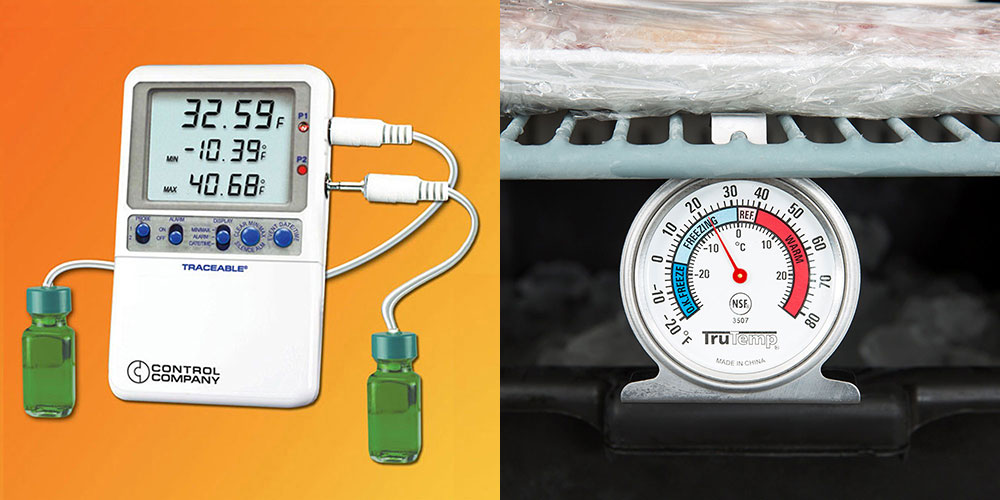
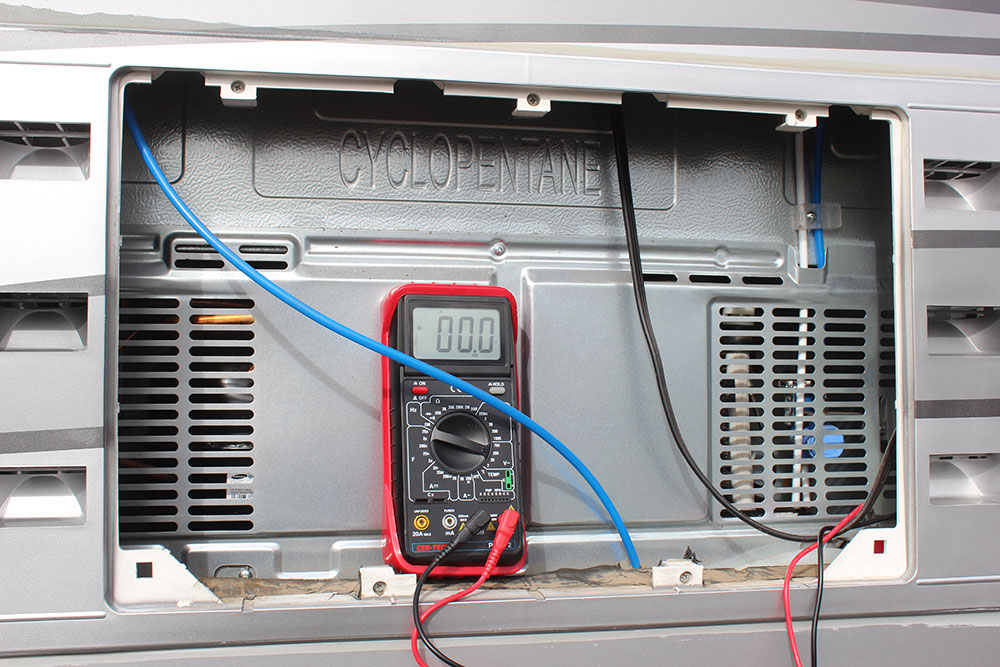
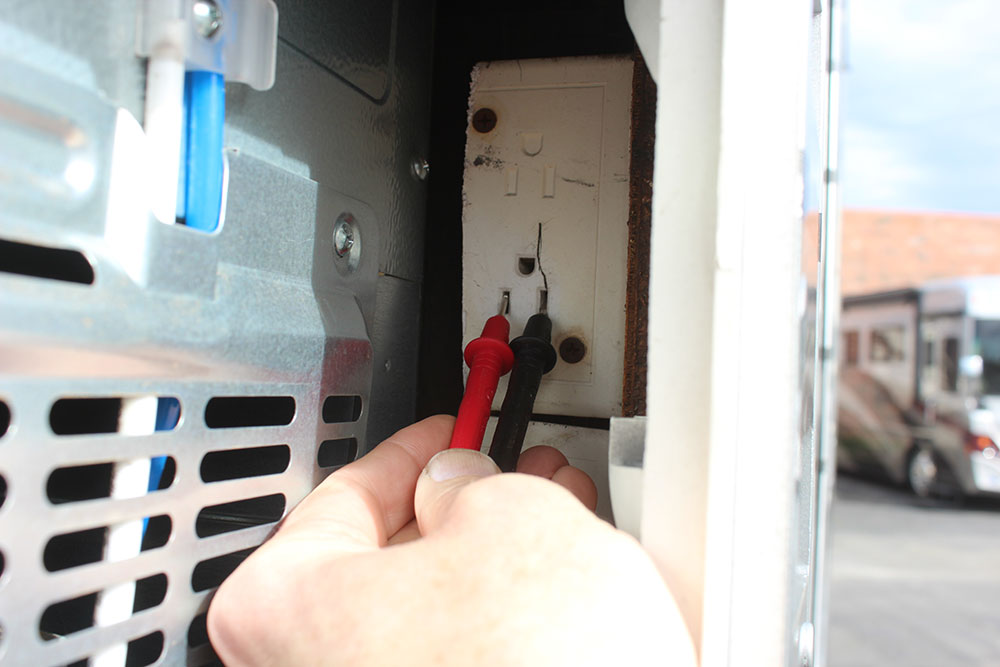
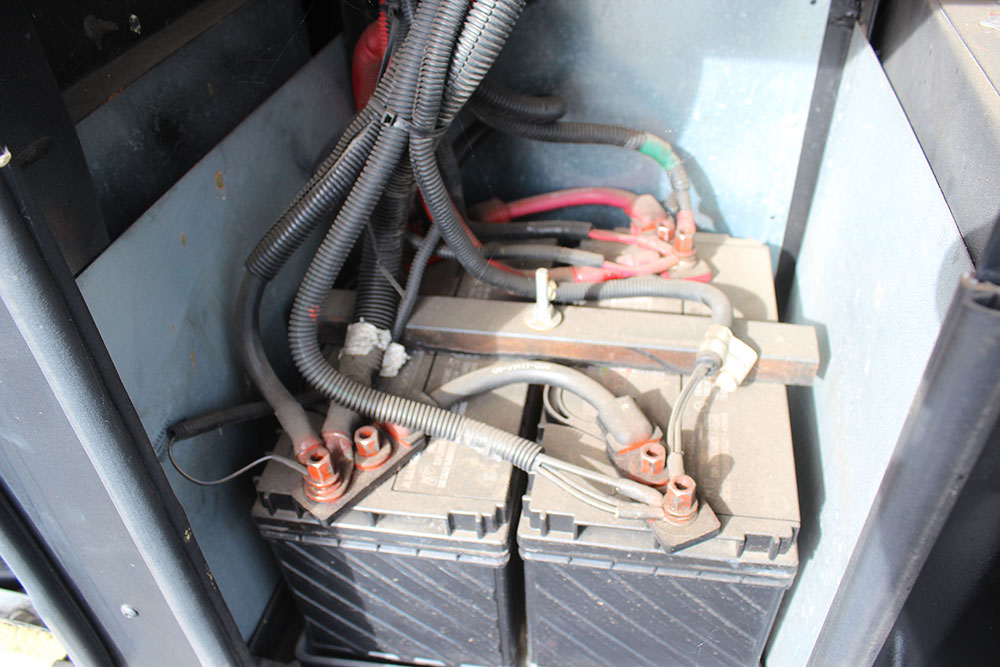
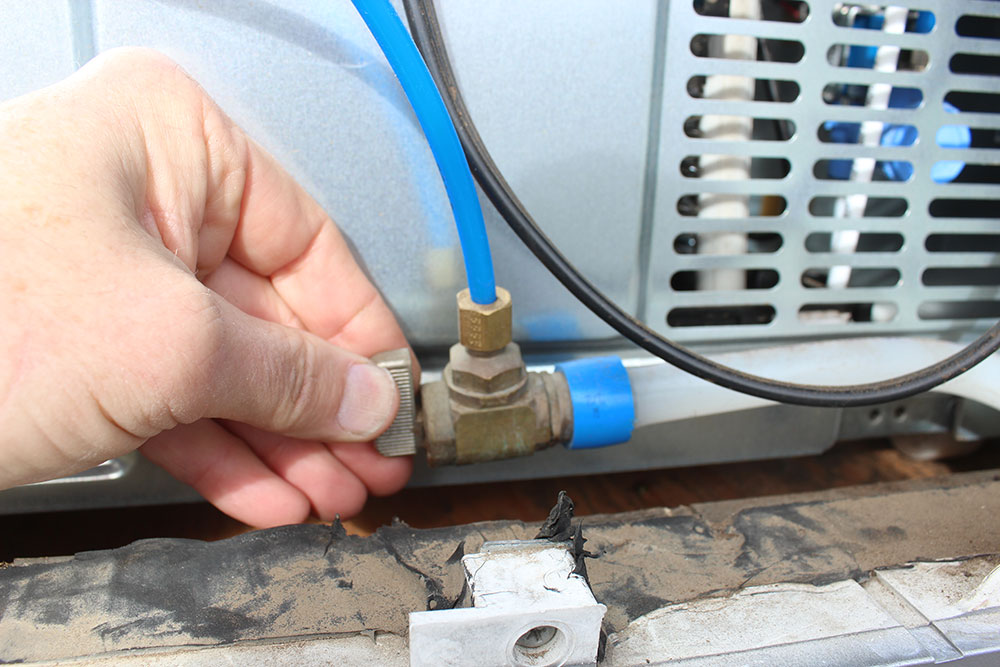

Refrigerant works great on LP gas but nothing works on 120 volts electric change heating element still nothing only lights work on 120 volts and no check light coming on. Thinking maybe critic board next any ideas. thanks
Looking at a used rv. Refrigerator has a light brown stain in freezer compartment at top/front liner where it slopes upwards. There are tiny scratches or cracks. It almost looks as if it was caused by heat. Any ideas? Thanks Brad
Refrigerator getting too cold no matter where I set the sliding thermostat
Norcold fridge not getting cold but burner is hot and have ac & DC power present.
Hi, I'm a full time rver. I bought the trailer new 10/18. It's been in continuous use since then. My refrigerator is AC/LP. It had worked well, but recently the freezer will be 5 F, but the refrigerator will be 42 or so. There are no error codes. It seems to work a little better on gas getting the refrigerator down to 37. I had frost in the freezer area so I defrosted the freezer. I've checked the ac power. Could this be a faulty thermistor or electric heating element? I can check the thermistor with an ohm meter. Thanks for you help. Steve
Refrigerator not cooling- gets to 46 freezer to 16 on 120v. There is a flame when on Gas, still doesn't cool down. Temp in the 80's
Replaced ice maker but it doesn't work
The fuse continues to blow after 2-3 days. What could cause this?
How do i replace this
My refrigerator gets cold in both LP and 110 modes. However, the unit totally shuts off after a brief period of time --sometimes after a few minutes, sometimes after an hour or. The fridge is level. I have tested for both AC and DC at back of unit and I have sufficient power -- including up to 110 heating element. I have bypassed board and tested 110 heater and it works fine. I have checked fuses on board and they are fine. I am thinking it is either the control board or the eyebrow circuit. How do I test those independently, or do you have other suggestions? Control box part is 618574 and eyebrow circuit is 618588. Thank you.